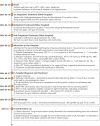A Case Report of Unusual Diagnosis of Melioidosis in a Non-Traveler: Implications for Transmission and Diagnosis
- PMID: 40727382
- PMCID: PMC12301130
- DOI: 10.2147/IDR.S528971
A Case Report of Unusual Diagnosis of Melioidosis in a Non-Traveler: Implications for Transmission and Diagnosis
Abstract
Melioidosis is prevalent in Southeast Asia, acquired via breathing or skin contact with water or soil contaminated by Burkholderia pseudomallei. This article reports a 42-year-old male melioidosis patient without underlying diseases or travel history to epidemic areas, discussing its significance for epidemiology, diagnosis and treatment in non-epidemic areas. The patient's clinical manifestations, disease progression, previous treatment, admission examination, diagnostic process, treatment and follow-up results were retrospectively analyzed. tNGS, microbial culture and WGS were used for sample and pathogen identification and genetic analysis. The patient had recurrent fever with erythema nodosum on the left lower limb. Misdiagnosed and treated ineffectively in other hospitals, he was diagnosed with melioidosis in the Second Affiliated Hospital of Jiaxing University. The strain was identified as Burkholderia pseudomallei, type ST46. Appropriate antibiotic treatment was selected based on drug sensitivity test results. After 6 months of follow-up, most lesions were absorbed, laboratory indicators normalized and the clinical effect was good. Epidemiological investigations suggested ST46 might be transmitted via non-traditional routes related to the fact that 15 days before the onset of the disease, the patient had purchased live turtles and the soil for raising them online which were sourced from Yunnan, indicating the possibility of geographical transmission. This case enriches understanding of melioidosis' non-traditional transmission, strain transmission, clinical diagnosis and treatment, highlighting the importance of considering the disease in non-endemic areas' differential diagnosis and the need for further epidemiological surveillance and research.
Keywords: melioidosis; non-endemic areas; non-traditional transmission; targeted next-generation sequencing.
© 2025 Fan et al.
Conflict of interest statement
The authors report no conflicts of interest in this work.
Figures





Similar articles
-
Signs and symptoms to determine if a patient presenting in primary care or hospital outpatient settings has COVID-19.Cochrane Database Syst Rev. 2022 May 20;5(5):CD013665. doi: 10.1002/14651858.CD013665.pub3. Cochrane Database Syst Rev. 2022. PMID: 35593186 Free PMC article.
-
Case Report: Soft tissue infection with Burkholderia thailandensis capsular variant: case report from the Lao PDR.Wellcome Open Res. 2024 Nov 28;9:421. doi: 10.12688/wellcomeopenres.22706.3. eCollection 2024. Wellcome Open Res. 2024. PMID: 39246519 Free PMC article.
-
Home treatment for mental health problems: a systematic review.Health Technol Assess. 2001;5(15):1-139. doi: 10.3310/hta5150. Health Technol Assess. 2001. PMID: 11532236
-
Comparison of Two Modern Survival Prediction Tools, SORG-MLA and METSSS, in Patients With Symptomatic Long-bone Metastases Who Underwent Local Treatment With Surgery Followed by Radiotherapy and With Radiotherapy Alone.Clin Orthop Relat Res. 2024 Dec 1;482(12):2193-2208. doi: 10.1097/CORR.0000000000003185. Epub 2024 Jul 23. Clin Orthop Relat Res. 2024. PMID: 39051924
-
Severe Relapsing Hailey-Hailey Disease Displaying a Durable Complete Response to Hydroxyurea.Acta Dermatovenerol Croat. 2024 Nov;32(3):168-169. Acta Dermatovenerol Croat. 2024. PMID: 40654217
References
-
- Mou S, Savchenko V, Filz V, Böttcher T, DeShazer D. Burkholderia pseudomallei produces 2-alkylquinolone derivatives important for host virulence and competition with bacteria that employ naphthoquinones for aerobic respiration. Front Microbiol. 2024;15:1474033. doi: 10.3389/fmicb.2024.1474033 - DOI - PMC - PubMed
Publication types
LinkOut - more resources
Full Text Sources

